ASUS E35M1-M Pro Review - Anyone For Fusion?
by Brendan van Varik on October 25, 2011 5:00 AM EST- Posted in
- Asus
- Motherboards
- Fusion
- E-350
LAN Speed Test
LAN Speed Test is a freeware program designed for testing the network connection between two PCs on a home network. The speed of the transfer is limited by the lowest common denominator on the network, so if you have gigabit Ethernet capable computers but a 100 Mbit capable router, you are limited to 100 Mbit transfer. Note that this is really a formality – if a network port is rated at 1 Gbps, then chances are that it will hit at least 90+% of this value. The main test here is CPU usage, and how much is offloaded by the controller. For this test, we use LAN Speed Test to transfer a 1000 MB file across a home network with a 1000 Mbps lowest common speed to the same machine each time, in a read/write scenario.
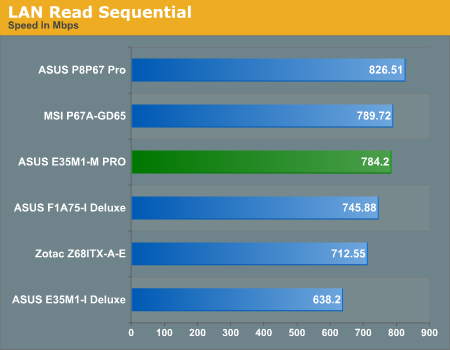
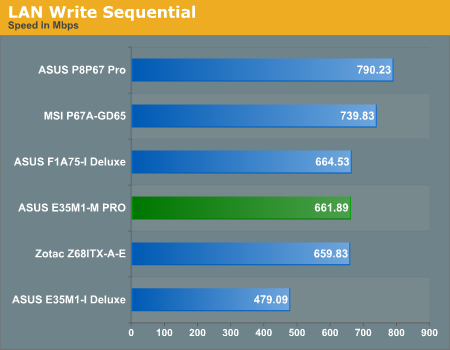
As we only have two results on the A50M platform which were tested under a 1 Gbps environment, I have decided to compare it to a few other platforms too. LAN throughput should be down to the onboard chip and therefore it has been compared to these platforms. Judging by the read and write speeds, the E35M1-M Pro does well for itself and is above average in the read tests but falls just under the average marker with the write tests.
USB Speed
For this benchmark, we run CrystalDiskMark to determine the ideal sequential read and write speeds for the USB port using our 64GB Patriot SuperSpeed USB 3.0 drive. Then we transfer a set size of files from the SSD to the USB drive, and monitor the time taken to transfer. The files transferred are a 1.52 GB set of 2867 files across 320 folders – 95% of these files are small typical website files, and the rest (90% of the size) are the videos used in the Sorenson Squeeze test.

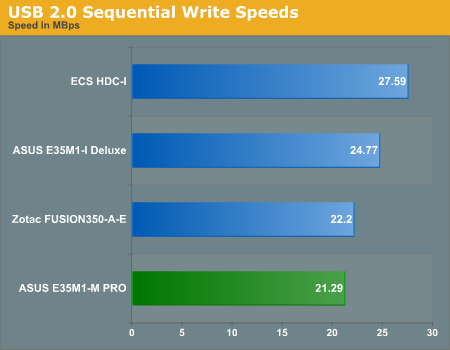
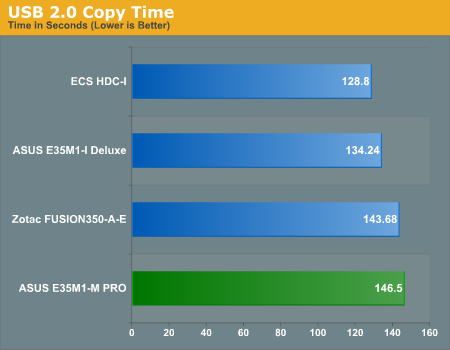
The USB 2.0 read speeds are above average out of the four boards but the writes on the other hand come in at bottom place. The reason for this is unknown.
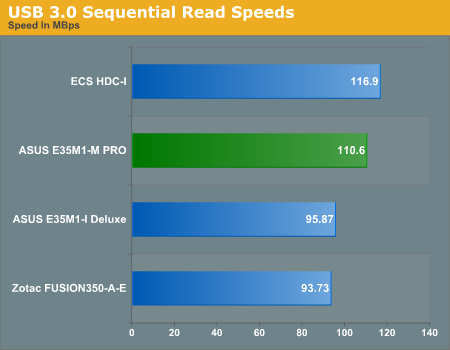

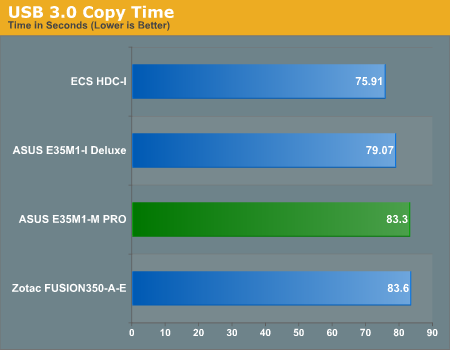
Write speeds on the USB 3.0 side of things are much better than the USB 2.0 results and the read speeds are above average here as well.
SATA Testing
We also use CrystalDiskMark for SATA port testing. The operating system is installed on the OCZ Vertex 3 240GB SSD, which is rated at up to 550 MB/s read and up to 520 MB/s write, and the sequential test is run at the 5 x 1000 MB level on a separate clean partition. This test probes the efficiency of the data delivery system between the chipset and the drive, or in the case of additional SATA ports provided by a third party controller, the efficiency between the controller, the chipset and the drive.


In the Vertex 3 testing the board got the fastest read speeds for A50M but the write speeds were below average. It is debatable whether a user would notice this is regular usage for this board, however.
DPC Latency
Deferred Procedure Call latency is a way in which Windows handles interrupt servicing. In order to wait for a processor to acknowledge the request, the system will queue all interrupt requests by priority. Critical interrupts will be handled as soon as possible, whereas lesser priority requests, such as audio, will be further down the line. So if the audio device requires data, it will have to wait until the request is processed before the buffer is filled. If the device drivers of higher priority components in a system are poorly implemented, this can cause delays in request scheduling and process time, resulting in an empty audio buffer – this leads to characteristic audible pauses, pops and clicks. Having a bigger buffer and correctly implemented system drivers obviously helps in this regard. The DPC latency checker measures how much time is processing DPCs from driver invocation – the lower the value will result in better audio transfer at smaller buffer sizes. Results are measured in microseconds and taken as the peak latency while cycling through a series of short HD videos - under 500 microseconds usually gets the green light, but the lower the better.

The E35M1-M PRO currently holds the lowest DPC Latency score in our records for the A50M platform.










66 Comments
View All Comments
frilans - Saturday, December 3, 2011 - link
Sandy Bridge can be passively cooled to safe temperatures under load. We have Intel Core i3-2105 (TDP 65W) processors in our office computers. I have built them with no moving parts in the H3.S case with passive cooling from HD-Plex (www.hd-plex.com)./Chris
duploxxx - Tuesday, October 25, 2011 - link
much cheaper? the lowest priced mobo and the lowest price celeron will only get you in the same price range.not to mention the way higher TDP and I would love to see some GPU performance compares.
medi01 - Sunday, October 30, 2011 - link
SB celeron + motherboard is NOT "much cheaper than this APU".Stop spreading FUD, Intel fanboi.
plonk420 - Wednesday, October 26, 2011 - link
you can take the fan off just fine. ran for half a day like that.just to be nice, i put a PWM 120mm fan over it in the htpc case. can't hear it nor the PCP&C Silencer currently over my fridge running across the room.
davos555 - Tuesday, October 25, 2011 - link
It is good for basic tasks - However I had one and it stuggles to play back HD video content - the hardware decoding doesn't work in linux media players because of lack of drivers. Apparantly it works best in Windows media players such as MPC but I havent test this!spaceyyeti - Tuesday, October 25, 2011 - link
use xbmc. works great for me.C300fans - Tuesday, October 25, 2011 - link
Yeah, SB will get much more ppd if you are crunching BOINC.futurepastnow - Tuesday, October 25, 2011 - link
Great board for HTPC- unless you want to play modern 3D games on your TV. Then you'll need to step up to something with more CPU and graphics power.Also looks like it would be great for a home server, or a family member who only surfs the web and watches videos (that covers a lot of people).
mepenete - Wednesday, October 26, 2011 - link
runnin AMD for graphics? Nothin but trouble if you're in Linux.gevorg - Tuesday, October 25, 2011 - link
Couple of questions:1) Can this thing FLAWLESSLY play high bitrate HD 1080p from a hard drive or blu-ray disk?
2) How good is the 23.976 playback?